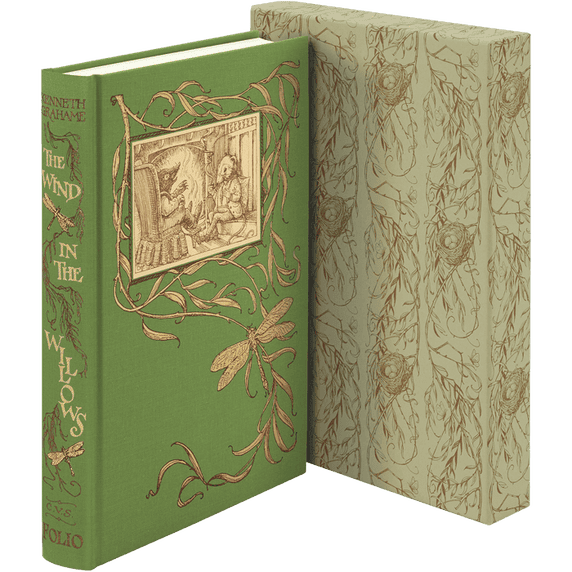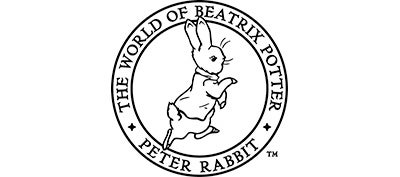

The timeless adventures of Toad, Mole, Ratty and Badger have enchanted children and their parents for more than a century. This is a glorious edition of a children’s classic, with enchanting illustrations by Charles van Sandwyk.
Foreword by Emma Thompson
Commentary by Sara Glenn
This collection of rarely seen editions of Beatrix Potter’s much loved debut, The Tale of Peter Rabbit, features exquisite facsimiles from the archive of her publisher Frederick Warne & Co. Ltd., charting the transformation from Peter’s initial appearance in a picture letter, to the glorious full-colour deluxe first commercial edition.
‘Peter Rabbit – long-eared anarch, blue-coated friend, furry comfort of my youth, it is hard to put into words the importance of his presence in the world and in my own childhood.’
- Emma Thompson, from her foreword
To mark the 120th anniversary of a story that has delighted countless children, the Folio Society is excited to publish exclusive editions of Beatrix Potter’s inimitable classic, The Tale of Peter Rabbit. Strictly limited to 1,000 hand-numbered sets, these meticulously produced facsimiles perfectly replicate treasures from the archive of her publisher Frederick Warne and Co. Collectors can follow the emergence of the miniature masterpiece from the seeds of the story in a now famous picture letter written to entertain a sick child, through Beatrix Potter’s privately printed edition with its distinctive line drawings, to the mock-up book – or maquette – handwritten in Potter’s beautiful script showing exactly how she wished the words and pictures to appear. With the full-colour commercial deluxe version first produced in 1902, the transformation is complete. Also tucked inside the elegant presentation box are charming replicas of five tiny Christmas letters, a giclée print of Peter wearing his signature blue jacket, and a hand-numbered limitation certificate. The set is completed by a specially commissioned commentary volume comprising a delightful foreword from renowned actor, screenwriter and Beatrix Potter devotee Dame Emma Thompson, and a richly illustrated, authoritative history of The Tale written by Sara Glenn, Commercial Curator of the Warne Archive.
Facsimile of picture letter, 1893, printed on Arena Wove paper
8 pages. 8˝ × 4¾˝
Facsimile of privately printed edition, 1901
Bound in Wibalin paper
Printed on Sirio Calce Stucco paper
88 pages. 5¾˝ × 4¼˝
Facsimile of maquette, 1902
Printed on Arena Wove paper
Presented in an archive folder made from Sirio Color paper blocked in silver foil
88 pages. 5˝ × 3¾˝
Facsimile of deluxe edition, 1902
Bound in cloth with an inset label
Printed on Sirio Calce Stucco paper
Gold page tops
Printed endpapers
104 pages. 5½˝ × 4˝
Five Christmas letters printed on Arena Wove paper
Each 3˝ × 1½˝
Giclée print on Modigliani Insize Neve paper with blind embossed frame line
9˝ × 6½˝
Limitation certificate printed letterpress on Fedrigoni Tintoretto Ceylon paper
Commentary set in Caslon, printed on Abbey Pure paper and bound in Sirio Color paper blocked in silver foil
80 pages. 9½˝ × 6½˝
Presentation box covered in cloth blocked in silver and blue and lined with paper blocked in silver with a design taken from an illustration 14˝ × 13¾˝ × 2˝
From the moment it appeared in October 1902, The Tale of Peter Rabbit has charmed every generation – the first edition of 8,000 copies sold out before it had even been released! But with Potter’s insistence that the ‘Bunny Book’ be small enough for tiny hands to hold and affordable for ‘little rabbits’, it was for a time uncertain that it would be published at all.
Peter’s adventures first appeared in a picture letter written to amuse Noel Moore, the 5-year-old son of Beatrix Potter’s last governess and close friend Annie, as he recovered from a bout of scarlet fever. Many years later, Annie suggested that the exploits of this ‘very naughty’ rabbit might make a good first book and encouraged Beatrix to borrow her original letter and craft a longer story. But the tale was repeatedly rejected by publishers so, not to be thwarted, Potter used her own savings to publish the first edition privately, before finally striking a deal with Frederick Warne and Co., who agreed to her stipulations on price and size, provided she produce the illustrations in colour.
The enchanting combination of Potter’s lively text and her evocative watercolour and pen-and-ink vignettes produced one of the most enduring, endearing, and instantly recognisable heroes in all of children’s literature, and launched her career as the author of a series of beautifully made, universally acclaimed ‘little books’.
‘It is all the same, drawing, painting, modelling, the irresistible desire to copy any beautiful object which strikes the eye.’
- From Beatrix Potter’s Journal, 4 October 1884
From an early age, Beatrix Potter displayed an unusual talent for wildlife drawing, a vivid imagination, and a particular affinity for rabbits. Throughout her life she kept rabbits as pets – including ‘Peter Piper’ whose antics inspired The Tale of Peter Rabbit – constantly observing their character and behaviour, regularly sketching and painting them and closely studying their anatomy. The success of her most famous creation stems from this combination of scientific knowledge, artistic skill, imagination and genuine affection. Peter looks and behaves like a real rabbit, and the world he inhabits is seen from a rabbit’s perspective. But he also shares many of the characteristics of a small child. He is bold and fearful, curious and queasy, despairing and exhausted, experiencing the thrills and shocks of Mr. McGregor’s Garden from a child’s point of view.
‘I do so hate finishing books, I would like to go on with them for years.’
- Beatrix Potter
Beatrix Potter was a self-proclaimed perfectionist, who devoted extraordinary care to every aspect of her books. She took pride in cutting and polishing her text and drawing and re-drawing the illustrations; helped choose the paper for the text pages and bindings; selected the size and style of the font; approved the printing blocks and the colours to be used; and revised the proofs to correct punctuation, wording and even spacing.
These same meticulous standards have been applied to the production of this anniversary edition, from the design of the cloth-covered box – complete with navy ribbons to allow the books to be removed safely from their recesses, and a specially designed lining showing Peter hiding in the cabbage patch – to the paper binding of the privately printed edition, the thread-sewn pages of the maquette and the cloth-bound deluxe edition with endpapers replicated from the original and gilded page tops. Every page of the originals has been newly photographed for the facsimiles to show the delicacy of Beatrix Potter’s original work and the wonderful softness of her colouring. This glorious presentation of Potter’s finest tale is sure to delight even the most ardent fan.

